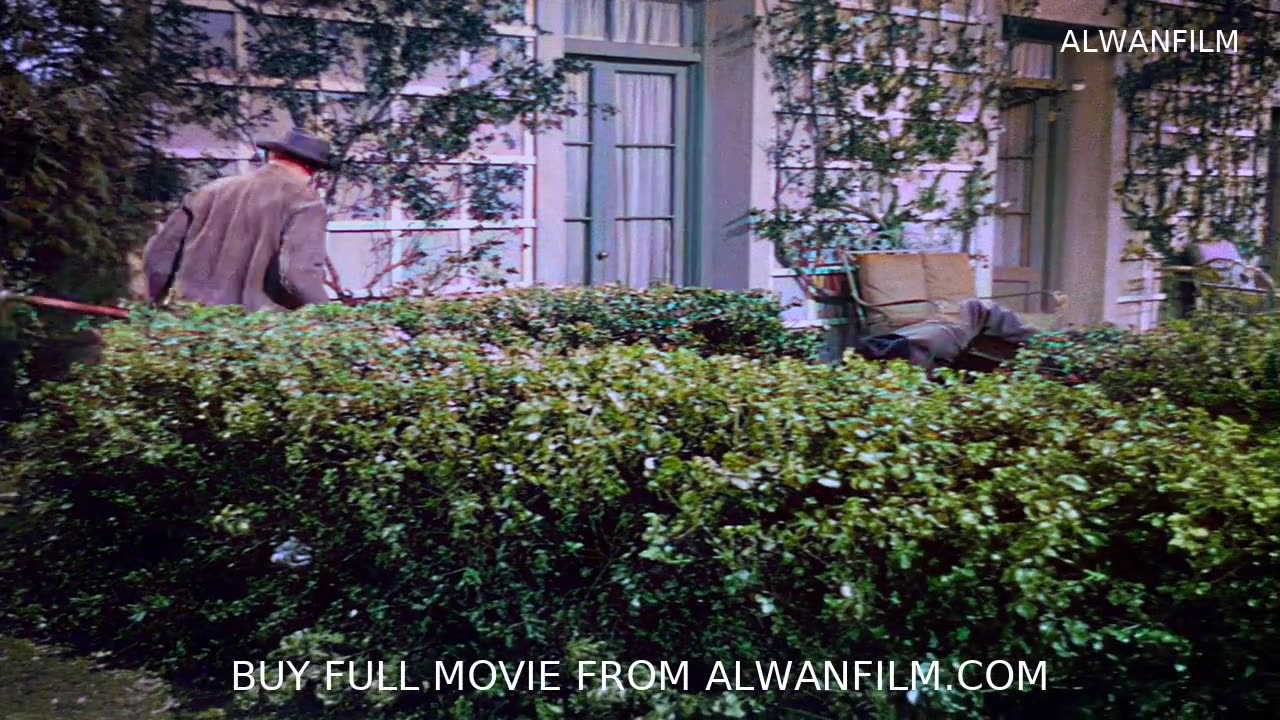Premium Only Content

The Fuller Brush Man Colorized
The Fuller Brush Man Colorized
Review: The Fuller Brush Man 1948 Colorized - A Comedy Classic in Technicolor
Introduction
In the annals of classic American cinema, few comedies remain as charming and delightfully chaotic as "The Fuller Brush Man" from 1948. Directed by S. Sylvan Simon and starring the inimitable Red Skelton, this film represents a golden era of Hollywood comedy. But what happens when such a black-and-white classic is given a fresh coat of color? In this article, we delve into the impact of colorizing "The Fuller Brush Man," exploring its significance in the history of film and the ongoing debate about colorization's role in preserving cinematic heritage.
Check The Full Colorized Movies List
Check Our YouTube Channel
Check Our Colorized Movies Trailer Channel
Understanding The Fuller Brush Man 1948 Colorized: Director, Cast, and Genre
"The Fuller Brush Man" is a quintessential screwball comedy directed by S. Sylvan Simon, who was known for his deft touch in the genre. The film stars Red Skelton as the hapless but lovable protagonist, alongside Janet Blair, who plays his supportive yet skeptical fiancée. This film is a prime example of post-war American humor, blending slapstick, clever dialogue, and a dose of romantic entanglements.
Skelton's performance as the bumbling Fuller Brush salesman, Red Jones, is a masterclass in physical comedy and timing. Blair complements him perfectly, adding wit and charm to their on-screen chemistry. The genre is marked by its light-hearted narrative, fast-paced action, and humorous mishaps, all of which "The Fuller Brush Man" delivers in spades.
Exploring the World of The Fuller Brush Man 1948 Colorized: Plot and Characters
"The Fuller Brush Man" follows Red Jones, a clumsy and unlucky man who decides to try his hand at selling Fuller brushes door-to-door after losing his job. His adventure quickly spirals out of control as he becomes entangled in a web of mistaken identities, comedic misunderstandings, and a murder mystery.
The film's plot is a rollercoaster of hilarity, featuring a series of misadventures that lead Red from one precarious situation to another. From his disastrous sales attempts to his unintentional involvement in solving a crime, Red's journey is a nonstop riot. The supporting characters, including Janet Blair as Red's fiancée Ann Elliot and the various eccentric individuals they encounter, add depth and humor to the narrative.
The Art of Film Colorization
Film colorization, the process of adding color to black-and-white footage, has long been a subject of debate among filmmakers, critics, and audiences. Proponents argue that colorization makes classic films more accessible to modern viewers, who may be less inclined to watch black-and-white movies. Detractors, however, contend that it can compromise the artistic integrity and historical authenticity of the original works.
The colorization process involves digitally adding hues to the monochromatic frames, often guided by historical research and artistic interpretation. When done with care, it can enhance the visual appeal of classic films, bringing out details that might otherwise be overlooked. However, the risk lies in potentially altering the film's original mood and aesthetic, leading to a loss of the director's intended atmosphere.
Early Colored Films: A Brief History
The journey of color in cinema began in the early 20th century with various techniques, from hand-painting frames to using color tinting. The development of Technicolor in the 1930s revolutionized the industry, allowing filmmakers to create vivid, lifelike images that captivated audiences.
Technicolor's rich and saturated palette became synonymous with Hollywood's Golden Age, used to great effect in films like "The Wizard of Oz" and "Gone with the Wind." These early experiments laid the groundwork for the widespread adoption of color in filmmaking, transforming the visual language of cinema.
The Fuller Brush Man 1948 and Its Early Colored Version
The decision to colorize "The Fuller Brush Man" offers a fascinating experiment in bringing a beloved black-and-white comedy into the vibrant world of color. This version aims to reintroduce the film to contemporary audiences who might be more attuned to color films, providing a fresh perspective on its visual and comedic elements.
In its colorized form, "The Fuller Brush Man" reveals new dimensions of its slapstick humor and period setting. The bright hues of the costumes and sets enhance the comedic timing and physical gags, while the pastel tones of the 1940s suburban America add a layer of nostalgic charm. However, this transformation also raises questions about the preservation of the film's original style and the potential impact on its classic status.
The Debate Over Film Colorization
The colorization of classic films has always been contentious. On one side, advocates argue that colorization makes these films more appealing to younger generations, helping to preserve and revitalize cultural heritage. On the other side, purists believe that colorization distorts the original vision of the filmmakers and alters the historical context of the films.
The debate is particularly heated when it comes to films like "The Fuller Brush Man," which rely heavily on their original black-and-white cinematography to convey mood and humor. Critics of colorization often argue that it can dilute the impact of shadow and light, essential elements in black-and-white films that contribute to their unique visual storytelling.
Examining The Fuller Brush Man 1948 as an Early Colored Film
Viewing "The Fuller Brush Man" in its early colored version offers an intriguing opportunity to re-evaluate the film's comedic genius and visual appeal. The addition of color can enhance certain aspects, such as the vibrant energy of the physical comedy and the period details of the setting. However, it also prompts a reassessment of how color influences our perception of the film.
In the colorized version, Red Skelton's antics become even more vivid, with the bright palette accentuating his expressive face and exaggerated movements. The bustling streets, cozy homes, and lively characters all pop with newfound vibrancy, potentially attracting viewers who might overlook a black-and-white classic. Yet, this transformation may also lead some to question whether the essence of the film remains intact or if it loses something integral in the process.
Influence and Legacy: The Fuller Brush Man 1948 Colorized's Impact on Cinema
"The Fuller Brush Man" has left a lasting legacy in the realm of comedy, influencing subsequent generations of filmmakers and comedians. Its blend of slapstick, rapid-fire dialogue, and endearing characters set a standard for screwball comedies and continues to be celebrated for its timeless humor.
Red Skelton's performance in the film is a testament to his comedic talent, and his influence can be seen in the work of later comedians such as Jerry Lewis and Jim Carrey. The film's success also contributed to the popularity of the Fuller Brush brand, cementing its place in American cultural history.
Director's Cinematic Legacy: Beyond The Fuller Brush Man 1948 Colorized
S. Sylvan Simon's directorial career spanned various genres, showcasing his versatility and skill in crafting engaging stories. While "The Fuller Brush Man" remains one of his most well-known works, his filmography includes notable titles such as "The Fuller Brush Girl" and "Bewitched."
Simon's ability to balance humor, narrative pacing, and character development made him a respected figure in Hollywood. His contributions to the comedy genre, particularly through his collaborations with stars like Red Skelton, have left an indelible mark on the industry.
Themes Explored in The Fuller Brush Man 1948 Colorized
At its heart, "The Fuller Brush Man" explores themes of perseverance, ingenuity, and the pursuit of the American dream. Through Red Jones' misadventures, the film humorously addresses the challenges of finding and maintaining employment, the importance of honesty, and the value of determination.
The film also touches on the dynamics of love and relationships, as seen in Red's interactions with his fiancée Ann. Their comedic yet heartfelt exchanges highlight the trials and tribulations of romantic partnerships, adding an emotional layer to the otherwise lighthearted narrative.
Reception and Controversy Surrounding The Fuller Brush Man 1948 Colorized
Upon its release, "The Fuller Brush Man" was met with positive reviews from both critics and audiences, who praised its humor, pacing, and Skelton's performance. The film's success at the box office solidified its status as a beloved comedy of its time.
The recent colorized version, however, has sparked mixed reactions. While some appreciate the new visual appeal and accessibility, others argue that the original black-and-white cinematography should be preserved to maintain the film's historical and artistic integrity. This controversy reflects the broader debate over film colorization and its impact on classic cinema.
Where to Watch The Fuller Brush Man 1948 Colorized Online
For those eager to experience the comedic brilliance of "The Fuller Brush Man," the film is available on various streaming platforms. Both the original black-and-white version and the colorized edition can be found on services like Amazon Prime Video, YouTube Movies, and classic film streaming sites. This accessibility ensures that new audiences can discover and enjoy this timeless comedy, regardless of their preference for color or monochrome.
FAQs About The Fuller Brush Man 1948 Colorized
Common questions about "The Fuller Brush Man" include inquiries about its production, cast, and the implications of its colorization. Addressing these FAQs can provide deeper insights into the film's creation and legacy.
Q: Who directed "The Fuller Brush Man"?
A: The film was directed by S. Sylvan Simon, a notable director known for his work in comedies and dramas during the mid-20th century.
Q: What is the plot of "The Fuller Brush Man"?
A: The film follows Red Jones, a bumbling Fuller Brush salesman who becomes inadvertently involved in solving a murder mystery while attempting to sell brushes door-to-door.
Q: Why was "The Fuller Brush Man" colorized?
A: The colorization was part of an effort to make the film more appealing to modern audiences who might be less inclined to watch black-and-white movies. It aims to enhance the visual experience and attract a new generation of viewers.
Conclusion
In conclusion, "The Fuller Brush Man 1948" remains a quintessential example of classic American comedy, its humor and charm enduring through the decades. The colorized version offers a fresh take on this beloved film, sparking both interest and controversy within the cinematic community. Whether in vibrant color or original black-and-white, the essence of "The Fuller Brush Man" lies in its timeless comedy, memorable performances, and enduring legacy. As we continue to explore the possibilities and limitations of film colorization, it is essential to honor the artistic vision of directors like S. Sylvan Simon while embracing new ways to celebrate and preserve their work for future generations.
-
 1:00
1:00
AlwanFilm
3 days agoBunny Lake Is Missing 1965 Colorized
34 -
 17:55
17:55
DeVory Darkins
15 hours ago $19.15 earnedCNN crushed by pronouns as Trump scores HUGE VICTORY
58.4K62 -
 2:48:33
2:48:33
Barry Cunningham
16 hours agoWATCH LIVE: MY INTERVIEW WITH LARA TRUMP! AND TODAY'S NEWS ABOUT DEMOCRATS HATING AMERICA!
94.8K26 -
 3:12:15
3:12:15
TimcastIRL
9 hours agoLiberals BLAME TRUMP For NYC Tourist Helicopter Crash After Tragic Accident | Timcast IRL
252K157 -
 1:16:36
1:16:36
Glenn Greenwald
11 hours agoGlenn Takes Your Questions: On Banning Candidates in the Democratic World, Expanding Executive Power, and Trump's Tariffs | SYSTEM UPDATE #437
130K48 -
 40:09
40:09
Friday Beers
9 hours ago $6.31 earnedWii Golf Gets Heated: Friday Beers vs Full Squad Gaming
58.4K1 -
 44:53
44:53
Man in America
16 hours agoThe DISTURBING Truth About Tariffs That NO ONE Is Talking About
63.8K62 -
 32:30
32:30
Stephen Gardner
9 hours ago🚨BREAKING: Trump under INVESTIGATION for Stock Market Manipulation!
69.8K160 -
 59:50
59:50
Motherland Casino
6 hours agoMel x Zofie
34.4K5 -
 44:54
44:54
Ami's House
2 days agoThe Dave Smith Debate is Broken. Here's a Better Way In | Dave's Rogan Appearance
61.7K11